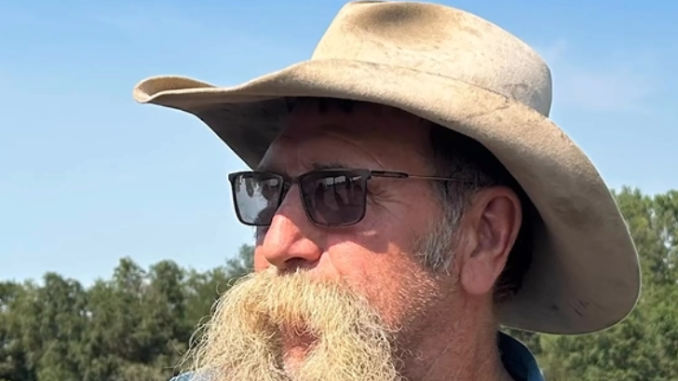
In the heart of South Dakota, where vast landscapes define rural life, an unexpected danger befell rancher Jim Lutter. While checking on a sick bison calf, he found himself face to face with a 3-year-old bull named Bill, a companion he had raised since it was a tiny calf.
What followed was beyond anyone’s expectations as Bill, the seemingly docile bison, suddenly turned aggressive, hooking Lutter with its horns, tossing him into the air, and ultimately goring him in the groin.
In the aftermath of the brutal encounter, Lutter’s survival journey became a testament to the vital role of telehealth in the most unexpected of places – the back of a basic life support ambulance, navigating the vast rural expanse of South Dakota.
The Unexpected Lifeline: Telemedicine in Motion
Instagram | kffhealthnews | Jim Lutter’s harrowing bison incident significantly highlighted the Telemedicine in Motion initiative.
Rural areas often grapple with the scarcity of advanced medical resources. In South Dakota, where small towns like Gann Valley are home to a handful of residents, the challenge amplifies. However, in a groundbreaking initiative, the South Dakota Department of Health introduced “Telemedicine in Motion,” a project that seamlessly integrates telehealth solutions into ambulance services across the state.
Jim Lutter’s dramatic encounter with the bison became a pivotal moment for this initiative. As he lay in the back of an ambulance, bleeding profusely, a telehealth system connected the rural medics to an emergency medicine physician based 140 miles away in Sioux Falls. This innovative approach to emergency care marked a paradigm shift in how rural emergencies are addressed.
The Rancher’s Tale of Survival
Jim Lutter’s ordeal didn’t end with the bison attack. Unable to reach his cell phone, he demonstrated remarkable resourcefulness by climbing into a front-end loader and driving to his brother Lloyd’s house. Lloyd, in turn, initiated a race against time, calling 911 and driving towards the ambulance base 18 miles away.
The challenges faced by rural ambulance services like the one in Kimball are multifaceted. Insurance reimbursements often fall short of covering operational costs, and these services heavily rely on a diminishing pool of aging volunteers. Ed Konechne, a volunteer EMT with the Kimball Ambulance District, emphasizes the unique challenges faced by rural medics, highlighting the infrequency of severe cases like Lutter’s.
Remote Expertise: A Lifeline for Rural Medics
Instagram | kffhealthnews | DeJong’s remote guidance was crucial in saving Lutter’s life.
Katie DeJong, the emergency medicine physician at Avel eCare’s telehealth center, played a pivotal role in guiding the ambulance crew’s actions. Reacting to the severity of Lutter’s injuries, including a collapsed lung and a chest cavity filled with air and blood, DeJong orchestrated a coordinated response.
From instructing the rural hospital in Wessington Springs on the necessary preparations to arranging a helicopter transfer to a Sioux Falls medical center, DeJong’s remote expertise became the driving force behind Lutter’s life-saving journey. The video call not only facilitated real-time communication but also allowed the ambulance crew to focus entirely on the immediate care of the patient.
A Technological Lifeline Across the State
The telehealth system that played a crucial role in Lutter’s survival was part of the Telemedicine in Motion initiative, funded by $2.7 million from state funds and federal pandemic stimulus money.
Spearheaded by Avel eCare, the initiative involved the installation of video equipment in ambulances and comprehensive training for medics across the state.
Freepik | rawpixel.com | Currently, 75 out of 122 ambulance services in South Dakota have adopted this revolutionary technology.
As of now, 75 out of 122 ambulance services in South Dakota have embraced this transformative technology, with an additional 18 planning to follow suit. The system has been utilized approximately 700 times, underscoring its significance in enhancing emergency medical responses in rural areas.
The Future of Telehealth in Rural Emergency Services
While Avel eCare’s contract is set to conclude in April, the hope is that South Dakota will extend the Telemedicine in Motion initiative into a third year. The challenge ahead lies in sustaining the program once the initial funding ends. Jessica Gaikowski, spokesperson for Avel eCare, reassures that patients will not face additional charges for telehealth services, leaving the onus on ambulance services to decide on continued participation.
In the vast landscapes of South Dakota, where unexpected dangers lurk on tranquil ranches, the combination of rural resilience and cutting-edge telehealth solutions has proven to be a lifesaving partnership. Jim Lutter’s tale of survival serves as a testament to the transformative impact of technology in the most unforeseen corners of our lives.
The post How Telehealth and Medical Technology Saved a Life in Rural America appeared first on Doctor Report.
